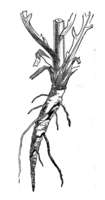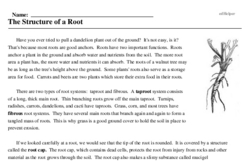The Structure of a Root
Have you ever tried to pull a dandelion plant out of the ground? It's not easy, is it? That's because most roots are good anchors. Roots have two important functions. Roots anchor a plant in the ground and absorb water and nutrients from the soil. The more root area a plant has, the more water and nutrients it can absorb. The roots of a walnut tree may be as long as the tree's height above the ground. Some plants' roots also serve as a storage area for food. Carrots and beets are two plants which store their extra food in their roots.
There are two types of root systems: taproot and fibrous. A taproot system consists of a long, thick main root. Thin branching roots grow off the main taproot. Turnips, radishes, carrots, dandelions, and cacti have taproots. Grass, corn, and most trees have fibrous root systems. They have several main roots that branch again and again to form a tangled mass of roots. This is why grass is a good ground cover to hold the soil in place to prevent erosion.
If we looked carefully at a root, we would see that the tip of the root is rounded. It is covered by a structure called the root cap. The root cap, which contains dead cells, protects the root from injury from rocks and other material as the root grows through the soil. The root cap also makes a slimy substance called mucigel (MUCE-ih-jell). This works to lubricate the growing roots and makes it easier for them to push through the soil.




